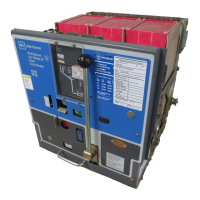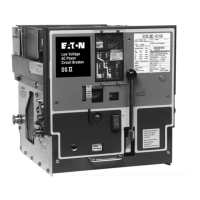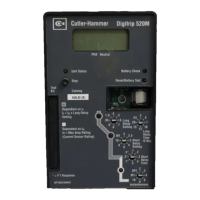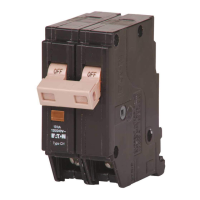1.8. 33-790-11
1. Anti-Rebound Latch
2. Open Position
Stop
(adjustable
for
DS-632 onlvl
Fig. 88 Open Position Stop and Anti-Rebound Latch
To replace the stationary contacts, the disconnect fingers
on the rear are removed and then the two bolts holding
the upper contact assembly to the molded base. With-
draw the contact assembly from the front. This should be
replaced with a new contact assembly. Make sure that all
bolts are securely tightened. Close the circuit breaker
and check all contact dimensions as described
in
Section
12.1.2.
12. 1.2.2 DS-632
and
DS-840
In
addition to the requirements for the DS-206, DS-206S,
DS-416, DS-416S and DS-420 above:
The lower main fixed contacts should be inspected to
ensure that they have adequate contact pressure. This is
determined by pin "X" being free to slide
in
the contact
cage (See Figures 86 and 87). Unlike DS-206/DS-416/
DS-420 breakers, the top row
of
fixed main contacts are
compressed beyond parallel position to assure adequate
contact pressure for lower row
of
fixed main contacts.
12.1.3 Replacement
of
Contacts
12. 1.3.1 DS-206
Both moving main and arcing contacts are held between
the two moving arms by two bolts with self-locking nuts.
Removal
of
the two bolts permits the replacement
of
the
moving contacts. These bolts must be securely tightened
after replacement.
The fixed arcing contacts are held by a single bolt pass-
ing through the contacts and their pressure springs. On
reassembly the self-locking nut is tightened so that a
dimension
of
3.12 inches is obtained between the inside
surfaces
of
the flat washers on the spring ends.
Effective October 1998
Page 77
12.1.3.2 DS-416, DS-4165, DS-420, DS-632
and
DS-840
The moving arcing and main contacts are secured to the
moving contact assembly
by
two bolts. Removal
of
these
bolts permits the replacement
of
the moving contacts.
To change the fixed arcing and main contacts, the fixed
contact assembly must first be removed from the pole
unit. Remove the disconnect fingers, remove the screws
holding the contact assembly to the pole unit base and
withdraw the contact assembly.
Obtain a new
or
reconditioned assembly and reassemble
in
the pole unit, with the holding screws finger tight. Close
circuit breaker and check the dimensions A (Figures 85,
86 and 87); they should be approximately equal.
If
not,
trip breaker and adjust fixed contact system until align-
ment is obtained. Tighten screws and contacts as
described
in
12.2.3.
12.1.4 Arc Chutes
The V-shaped slots
in
the arc chutes will undergo slow
erosion with arc interruptions. Switching operations will
give them a pitted, mottled and sooty appearance. This is
normal. Heavy fault interruptions will cause greater arc
erosion.
If
the steel splitter plates have more than 1/4 inch
of
material eroded away
at
the top
of
the V-shaped slots,
arc chutes should be replaced. This can be determined
by
comparing a plate near the center with a plate near
the end.
12.1.5 General Inspection
Look over all visible parts possible for missing pin retain-
ers, loose nuts, bolts
or
screws, bent, worn
or
damaged
parts. Make appropriate corrections to anything found out
of
order.
After any inspection make sure all parts are properly
installed on the breaker, especially arc chutes and all four
barriers.
12.1.5.1
Power
Operated
Mechanisms
Examine the driving face
of
the oscillator pawl. Refer to
Figures 15 and 16. Normal operation
of
the spring charg-
ing mechanism will result
in
the removal
of
plating from
the face
of
the pawl.
However, if the face is chipped, distorted
or
broken, it
should be replaced. Use Kit 694C525G01.
Courtesy of NationalSwitchgear.com

